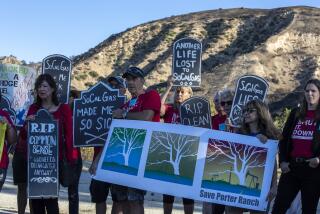Gas Industry’s Bubble Has Burst
- Share via
The agonizing time in California’s electricity business has resulted in an important lesson: The relationship between gas and electricity has permanently changed. And the way we regulate and plan for our energy needs also requires fundamental change.
For 15 years, natural gas was so plentiful in the U.S. that some saw it as virtually an infinite resource that would remain low-cost indefinitely.
But this year, the supply bubble burst. Gas prices have spiked to all-time highs, inflating the cost of gas-generated electricity and helping to touch off California’s summer power crisis. There is no relief in sight. We’re already telling our customers that natural gas heating bills for Southern California this winter will increase as much as 35%.
More than 800 offshore and land-based drill rigs are looking for gas across the U.S.--twice the number of March 1999. They’re looking for a pot of gold; gas now sells for $5.18 per million BTUs--three times the $1.60 futures price in March 1999.
One of the “cures” for California’s electricity woes is building gas-fired electric power plants. These will consume enormous amounts of fuel, causing supplies in the medium term to be very tight.
We have operated for decades with separate regulation of gas and electrical power sources. Our natural gas infrastructure has been designed to serve residential needs on days of extreme winter cold by implementing rules that require suspending service to electric generation whenever the residential customer loads become too large.
But the world has changed. Natural gas is now the fuel of choice for new power plants. Of the 50 electric-generation projects licensed for the western region, all use natural gas. In addition, existing generation facilities, while capable of burning fuel oil, are as a practical matter limited to burning natural gas because of increasingly strict air emission regulations. Those 50 plants will be capable of producing about 40,000 megawatts of power, which is about 80% of California’s consumption on a summer day.
Gas demand in California is now a year-round phenomenon. Use of natural gas once peaked in the winter, thus enabling utilities to store gas in the summer. But higher temperatures and growing air-conditioning demand resulted in this summer’s peak-demand day for gas to exceed last winter’s top peak-demand day for the first time ever.
The year-round demand--compounded by the need to replenish natural gas storage depleted by the effects of the pipeline explosion last month in New Mexico--has kept prices up in the West at a time when they normally ease.
In this new market, the age-old expectations regarding the seasonal nature of gas demand have changed. The production of electricity clearly is a high priority for our economy, and this will result in fundamental and desirable changes in the natural gas system. These changes are market-driven. It is now the job of policymakers to catch up to the market by expeditiously processing and approving the needed infrastructure improvements that result from a less seasonally driven demand for natural gas.
States need to ensure that the infracture needed to distribute utilities’ gas is built not only to accommodate cold winter needs but also to ensure sufficient delivery capability for power plants.
Local natural gas distribution companies can no longer expect to purchase cheap gas all summer for winter consumption. Pipelines and distribution companies must recognize and plan for these flatter consumption patterns.
In the end, a less seasonally driven gas market will result in greater efficiencies in the operation of the national transmission grid and a major cost savings to natural gas consumers.
At San Diego Gas & Electric, this may mean accelerating pipeline projects that are needed for residential service several years from now. Rules on how the utilities manage the intrastate systems also must be updated so that each participant’s responsibilities for providing reliable supplies are clearly defined and performance enforced. On the interstate transportation system, this means ensuring an adequate balance between supply and demand while avoiding overconstruction, which would only lead to high-cost inefficiencies.
We must ensure that equitable regulatory policies exist to ensure a market environment that spurs the necessary exploration and development of natural gas supplies to meet the growing demand.
As we have learned from the electric markets this summer, unless our gas markets are grounded in sound principles designed to promote competition and protect all market participants, the results can be most unpleasant. Now is the time to ensure sufficient transmission and distribution capacity so that competition can thrive and to ensure that, where competition does not exist, balanced regulatory policies protect all market participants.
We must ensure that the market for electricity becomes workably competitive in California and that the natural gas market stays workably competitive. The San Diego electricity crisis has sounded a warning bell to those who would hear. The consequence of ignoring this warning and allowing this summer’s events to be repeated in natural gas markets will be disastrous.
We in California are privileged to be on the leading edge of so many things, good and bad. Deregulation is one of them.
More to Read
Inside the business of entertainment
The Wide Shot brings you news, analysis and insights on everything from streaming wars to production — and what it all means for the future.
You may occasionally receive promotional content from the Los Angeles Times.










